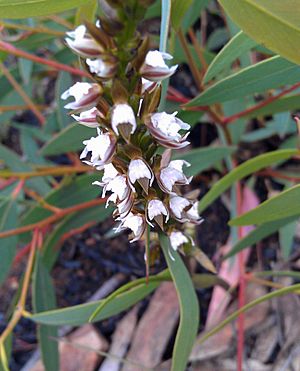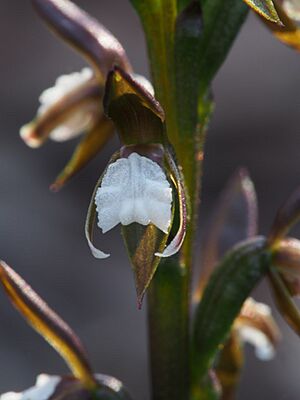Short-lip leek orchid facts for kids
Quick facts for kids Short-lip leek orchid |
|
|---|---|
 |
|
| Prasophyllum brevilabre growing on Black Mountain in the A.C.T. | |
| Scientific classification |
The short-lip leek orchid (scientific name: Prasophyllum brevilabre) is a special type of orchid that grows only in south-eastern Australia. It has a single, green, tube-shaped leaf. Its small flowers are greenish-brown with a white "lip" called a labellum. This labellum is quite unique because it sharply bends backward, almost touching its own base!
What the Short-Lip Leek Orchid Looks Like
The short-lip leek orchid is a plant that grows from the ground. It's a perennial plant, meaning it lives for more than two years. It's also deciduous, which means it loses its leaves at certain times. This orchid grows from an underground tuber, which is like a small storage organ.
It has one tube-shaped leaf that can be up to 350 millimeters (about 14 inches) long. The top part of the leaf, which is free from the stem, is usually 20 to 80 millimeters (about 0.8 to 3 inches) long.
Up to thirty flowers grow spaced out along a tall stem, which can be 150 to 500 millimeters (about 6 to 20 inches) high. The flowers are greenish-brown. Like other orchids in its group, these flowers are "inverted." This means their special "lip" (the labellum) is above the central part of the flower (the column), instead of below it.
The top part of the flower, called the dorsal sepal, is shaped like an egg or a spear. It's reddish-brown and about 7 to 8 millimeters (about 0.3 inches) long. The side sepals are about 10 millimeters (about 0.4 inches) long. Sometimes they are joined together, but often they are separate. The petals are thin and spear-shaped, 8 to 10 millimeters (about 0.3 to 0.4 inches) long. They can be wavy or curved like a sickle.
The labellum, or "lip," is shaped like a spoon. It's 8 to 10 millimeters (about 0.3 to 0.4 inches) long and about 3 millimeters (about 0.1 inches) wide. It bends sharply backward so its tip almost touches its base. The edges of the labellum are wavy.
These orchids usually bloom from September to January. They grow best and produce the most flowers after a bushfire happened the summer before.
How the Short-Lip Leek Orchid Got Its Name
This orchid was first officially described in 1840 by a scientist named John Lindley. He first called it Prasophyllum lutescens var. brevilabre. Then, in 1859, another scientist, Joseph Dalton Hooker, changed its name to Prasophyllum brevilabre.
The second part of its scientific name, brevilabre, comes from two Latin words:
- brevis means "short"
- labrum means "lip"
So, the name brevilabre means "short-lip," which describes its unique labellum.
Where the Short-Lip Leek Orchid Lives
The short-lip leek orchid is found in south-eastern Australia. You can find it in south-eastern Queensland, along the coast of New South Wales, and sometimes further inland, like near Mount Kaputar. It also grows in areas of Victoria that get a lot of rain, and it's common across Tasmania.
This orchid can live in many different places. It grows in coastal heathlands (areas with small, tough shrubs near the sea) and in forests. Sometimes, it even grows in subalpine regions, which are cooler areas found just below the treeline on mountains.


